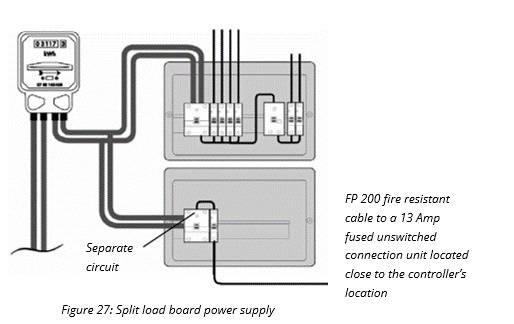6.11.4 Electrically Operated Devices
In accordance with BS 8458:2015, ‘the electrical supply to the Automist pump should be installed in such a way as to minimize the risk of electrical supply failure by having a separately fused connection taken after the meter and from the supply side of the domestic or residential fuse box, using fire-resisting cable’.
In the DIOM, we state our installation requirements:
Connecting the system to the mains requires a competent electrician with 18th Edition Electrical Qualifications. The Automist Smartscan Hydra circuit must be clearly labelled (a label is provided for this purpose). Automist Smartscan Hydra requires an independent 230V A.C. / 50Hz electrical supply, not shared with other unrelated devices. The Automist Smartscan Hydra system, fire detection and alarm system may use this circuit, which must remain powered in the event of a fire. Power to Automist Smartscan Hydra must be provided via an unswitched fused connection unit (FCU). Automist Smartscan Hydra must be supplied using FP200 cable or better, ideally inside conduit or protected 50mm deep within a wall, and with Miniature Circuit Breaker (MCB) and a Residual Current Device (RCD) (C type), or Residual Current Breaker with Overcurrent (RCBO) (C type) protection. RCD or RCBO protection may be required, however, by applicable electrical installation regulations, in which case the circuit design must be such that the operation of any other RCD, RCBO or safety device does not affect the operation of Automist Smartscan Hydra. An RCBO is preferred because if there is a fault on any one circuit it does not interfere with any other circuit. Typically, on a split-load board, Automist Smartscan Hydra must be connected to the non-protected side of the board. Where there are no spare ways in the existing consumer unit, or there are no available non-RCD protected ways in the existing consumer unit, the electrician may wish to use a Henley Block to provide new tails to a second distribution board (typically a 2- or 4-way unit) with no spare ways for future use. When prepay meters are present an additional prepay meter should be added specifically for Automist and housed within a lock box. The prepay meter for Automist must then be maintained with credit beyond its expected lifetime usage as part of the annual maintenance cycle.

The AP08 pump is intended for domestic and residential use only and therefore is of overvoltage Category II and has a Rated Impulse Voltage of 2.5kV. Depending on installation circumstances surge protection devices across the incoming mains supply might be required. The Automist Smartscan Hydra unit presents an inductive motor load and therefore only type “C” breakers are suitable. Because Automist Smartscan Hydra is often used for life safety applications, installers must add a suitable safety margin to the MCB ratings. By protecting the circuit supplying an Automist Smartscan Hydra with a C type breaker (C10’ or ‘C16’ for one unit (per pump), or ‘C20’ / ‘C32’ for two Automist Smartscan Hydra units) this safety margin is achieved. This must be on a C-type breaker, on an RCBO or an RCD protected circuit. The RCD/RCBO circuit must protect only the Automist Smartscan Hydra system and not be incorporated with any other circuit in the property. If the consumer unit is in the protected area, it must be protected by an electrical cover. However, if the consumer unit is in the protected area and has a metal enclosure complying with 18th Edition IET Wiring Regulations to BS 7671 2018; it does not require the addition of an over box to meet BS476 Part 22 (1987) and EN1364 (1999). To follow the requirements of BS 8458 it may require the use of fuses rather than MCBs, as a: ‘separately fused connection taken after the meter and from the supply side of the domestic or residential fuse box’.
Read more - Does Automist conform to the requirements of BS 8458?

